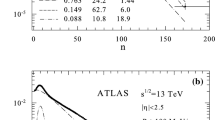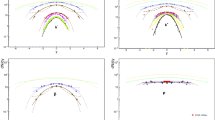Abstract
The probability density functions of proton, anti-proton, and net-proton multiplicity distributions are constructed from the Beam Energy Scan results of the STAR experiment using the Pearson curve method. The constructed distributions of proton and anti-proton are compared with Poisson and Binomial distributions. The net-proton probability distributions are compared with Skellam distributions to study the O(4) criticality near the chiral crossover transition. The \(C_{6}/C_{2}\) results estimated from the obtained PDFs are compared with Skellam and Binomial baselines for the Beam Energy Scan data. The current study shows some signatures of O(4) criticality, which can be further investigated by precision measurements of the cumulants and understanding the contribution of non-critical fluctuations to them. This study also provides a baseline for the higher order cumulant measurement in the upcoming RHIC BES II program and future LHC run.







Similar content being viewed by others
References
R.D. Pisarski, F. Wilczek, Phys. Rev. D 29, 338 (1984)
Y. Aoki, G. Endrodi, Z. Fodor, S.D. Katz, K.K. Szabo, Nature 443, 675 (2006)
S. Ejiri, Phys. Rev. D 78, 074507 (2008)
E.S. Bowman, J.I. Kapusta, Phys. Rev. C 79, 015202 (2009)
M.A. Stephanov, PoS LAT 2006, 024 (2006)
M. Asakawa, K. Yazaki, Nucl. Phys. A 504, 668 (1989)
Y. Hatta, T. Ikeda, Phys. Rev. D 67, 014028 (2003)
O. Scavenius, A. Mocsy, I.N. Mishustin, D.H. Rischke, Phys. Rev. C 64, 045202 (2001)
A.M. Halasz, A.D. Jackson, R.E. Shrock, M.A. Stephanov, J.J.M. Verbaarschot, Phys. Rev. D 58, 096007 (1998)
M.A. Stephanov, K. Rajagopal, E.V. Shuryak, Phys. Rev. D 60, 114028 (1999)
M.A. Stephanov, K. Rajagopal, E.V. Shuryak, Phys. Rev. Lett. 81, 4816 (1998)
M.A. Stephanov, Phys. Rev. Lett. 102, 032301 (2009)
F. Karsch, K. Redlich, Phys. Lett. B 695, 136 (2011)
B. Friman, F. Karsch, K. Redlich, V. Skokov, Eur. Phys. J. C 71, 1694 (2011)
A. Bazavov et al., Phys. Rev. Lett. 109, 192302 (2012)
S. Borsanyi, Z. Fodor, S.D. Katz, S. Krieg, C. Ratti, K.K. Szabo, Phys. Rev. Lett. 111, 062005 (2013)
S. Borsanyi, Z. Fodor, S.D. Katz, S. Krieg, C. Ratti, K.K. Szabo, Phys. Rev. Lett. 113, 052301 (2014)
Y. Hatta, M.A. Stephanov, Phys. Rev. Lett. 91, 102003 (2003)
L. Adamczyk et al., STAR Collaboration. Phys. Rev. Lett. 112, 032302 (2014)
X. Luo [STAR Collaboration], PoS CPOD 2014, 019 (2015)
J. Adam et al. [STAR], Phys. Rev. Lett. 126(9), 092301 (2021)
M. Abdallah et al. [STAR], Phys. Rev. C 104(2), 024902 (2021)
M. Bleicher et al., J. Phys. G 25, 1859 (1999)
A. Bzdak, V. Koch, V. Skokov, Eur. Phys. J. C 77(5), 288 (2017)
K. Morita, B. Friman, K. Redlich, V. Skokov, Phys. Rev. C 88(3), 034903 (2013)
K. Morita, V. Skokov, B. Friman, K. Redlich, Eur. Phys. J. C 74, 2706 (2014)
K. Morita, B. Friman, K. Redlich, Phys. Lett. B 741, 178 (2015)
Karl Pearson, Philos. Trans. R. Soc. Lond. A Math. Phys. Eng. Sci. 186, 343–414 (1895)
Karl Pearson, Philos. Trans. R. Soc. Lond. A Math. Phys. Eng. Sci. 197, 443–459 (1901)
J. H. Pollard, A Handbook of Numerical and Statistical Techniques. Cambridge University Press. ISBN 0-521-29750 (1977)
O. Podladchikova, B. Lefebvre, V. Krasnoselskikh, V. Podladchikov, Nonlinear processes in geophysics. Eur. Geosci. Union (EGU) 10, 323–333 (2003)
Wolfram Research, Inc. Mathematica, Version 11.2. Champaign (2017)
A. Pandav, D. Mallick, B. Mohanty, Nucl. Phys. A 991, 121608 (2019)
P. Garg, D.K. Mishra, P.K. Netrakanti, B. Mohanty, A.K. Mohanty, B.K. Singh, N. Xu, Phys. Lett. B 726, 691 (2013)
P. Braun-Munzinger, A. Kalweit, K. Redlich, J. Stachel, Phys. Lett. B 747, 292 (2015)
T.J. Tarnowsky, G.D. Westfall, Phys. Lett. B 724, 51 (2013)
A. Bzdak, V. Koch, D. Oliinychenko, J. Steinheimer, Phys. Rev. C 98(5), 054901 (2018)
D. Thakur, S. Jakhar, P. Garg, R. Sahoo, Phys. Rev. C 95(4), 044903 (2017)
P. Braun-Munzinger, A. Rustamov, J. Stachel, Nucl. Phys. A 960, 114 (2017)
M. Abdallah et al., STAR. Phys. Rev. Lett. 127, 262301 (2021)
X. Luo, N. Xu, Nucl. Sci. Technol. 28(8), 112 (2017)
Acknowledgements
The authors thanks the STAR Collaboration for providing the preliminary data during the initial phase of this study. The author acknowledges R. Bellweid, S. Dash, K. Morita and B. K. Nandi for their valuable suggestions during the preparation of this manuscript. This work was supported by the National Research Foundation of Korea (NRF) grant funded by the Korea government (MSIT) (No. 2018R1A5A1025563).
Author information
Authors and Affiliations
Corresponding author
Additional information
Communicated by R. Sharma.
Rights and permissions
About this article
Cite this article
Behera, N.K., Kweon, M.J. Constructing probability density function of net-proton multiplicity distributions using Pearson curve method. Eur. Phys. J. A 58, 43 (2022). https://doi.org/10.1140/epja/s10050-022-00696-9
Received:
Accepted:
Published:
DOI: https://doi.org/10.1140/epja/s10050-022-00696-9




